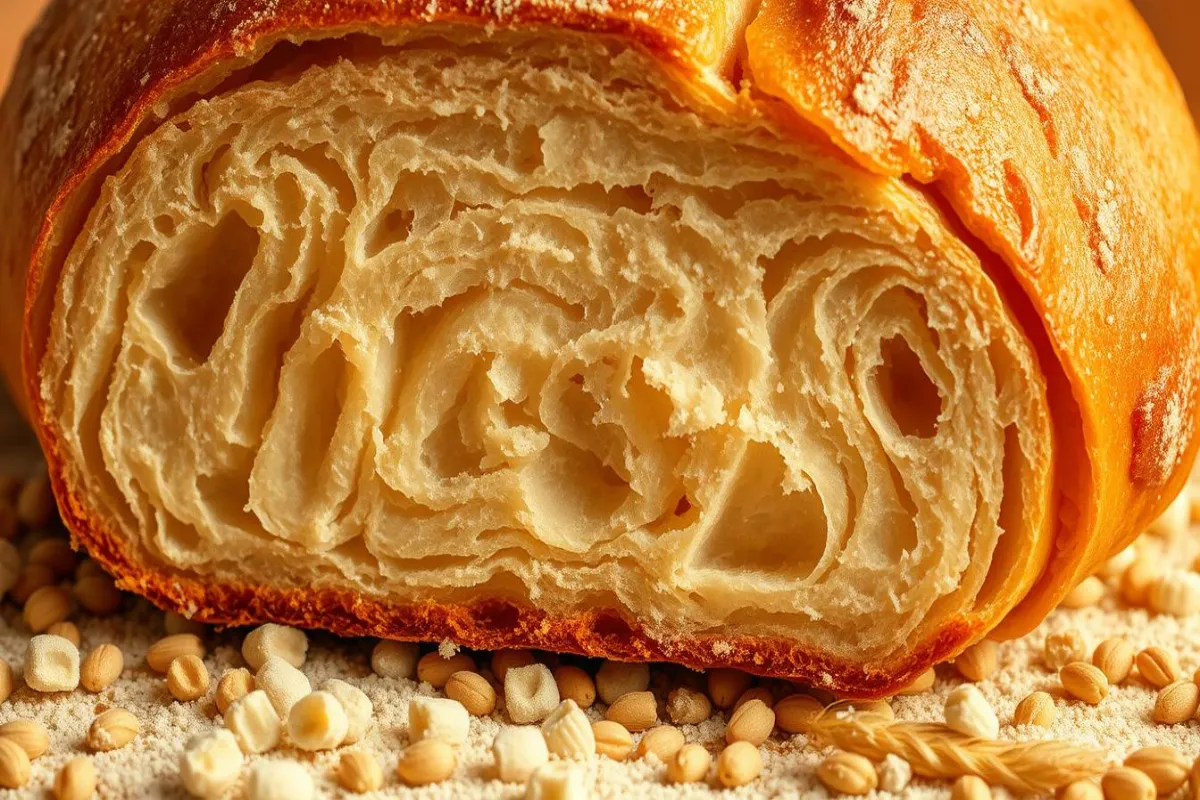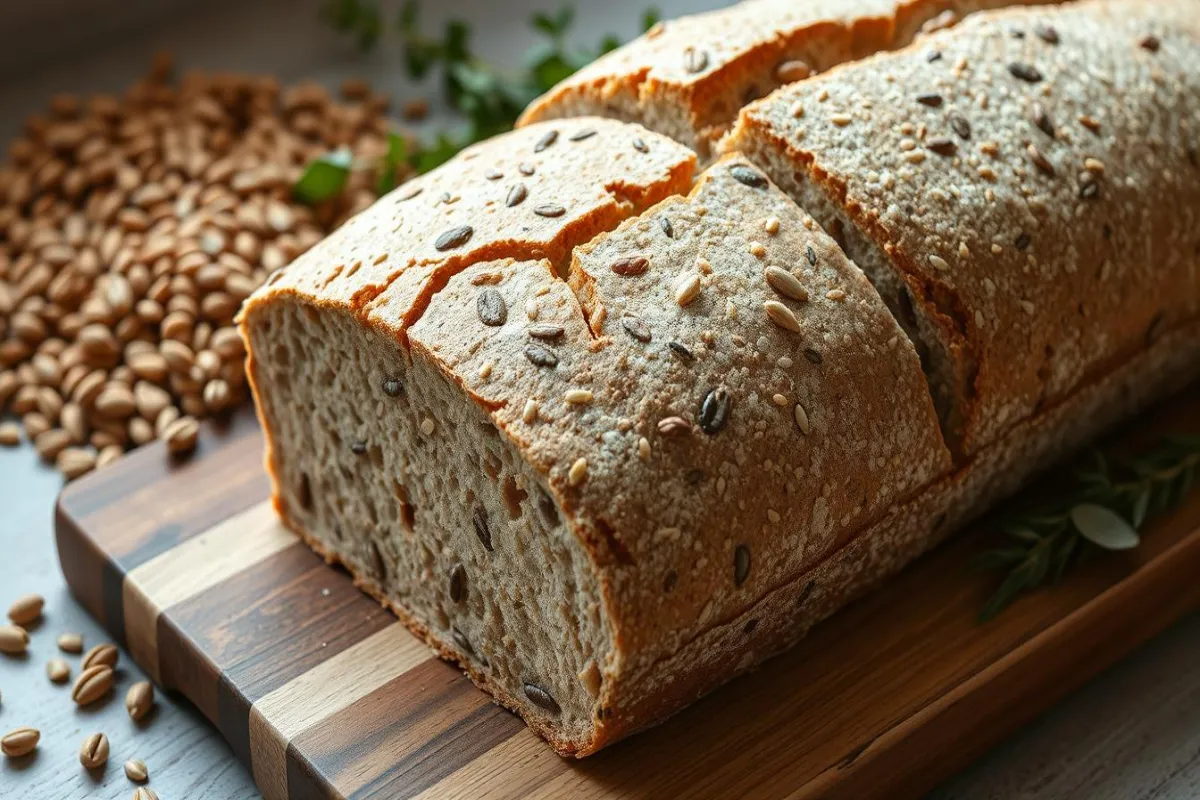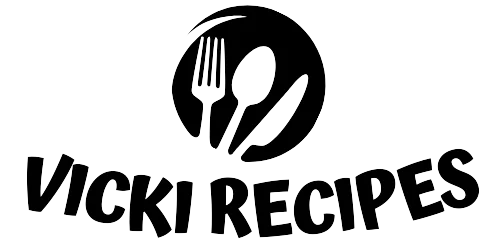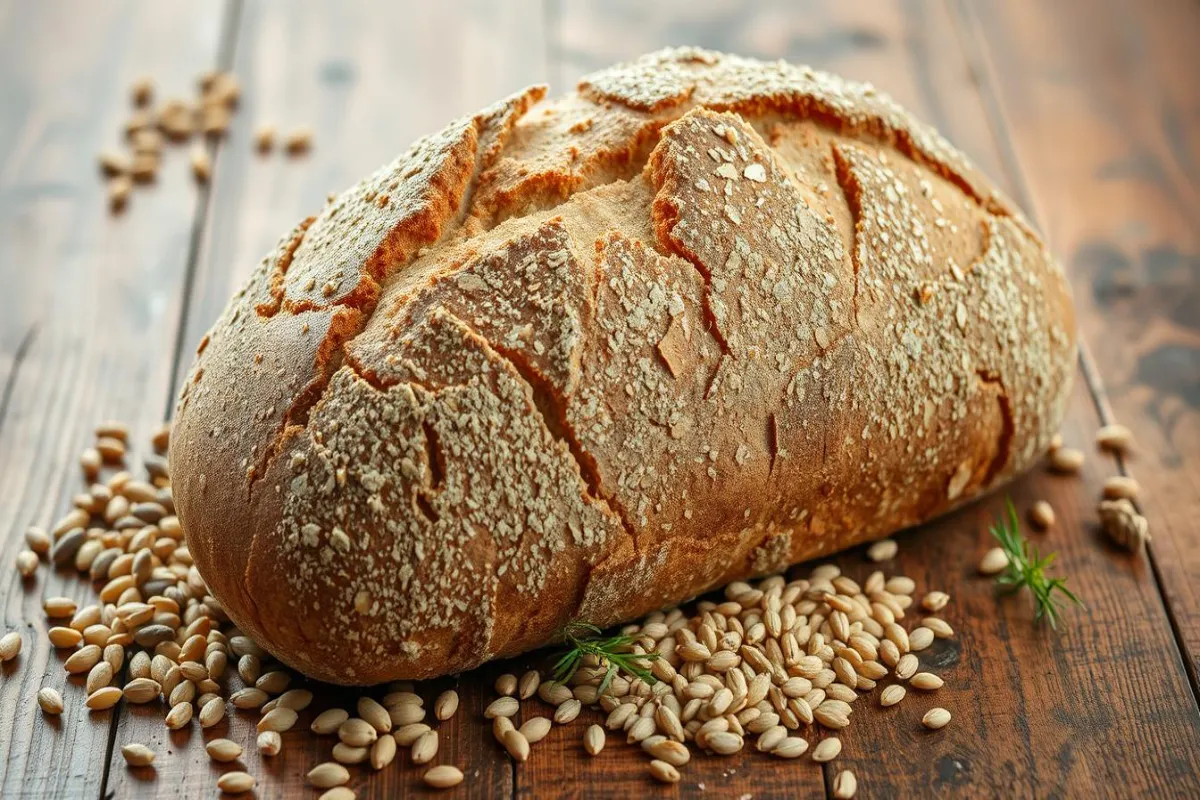I love whole grains and healthy eating. Ezekiel bread caught my eye because of its nutritional benefits. But, is it gluten-free?
In this guide, we’ll look at Ezekiel bread’s ingredients and gluten content. We’ll see if it’s good for those who need to avoid gluten. By the end, you’ll know if Ezekiel bread fits your diet.
Understanding Gluten and Its Role in Bread
Gluten is a protein found in wheat, rye, and barley. It’s key in making bread. It makes bread elastic and chewy, and helps it rise and keep its shape.
What is Gluten?
Gluten is made of two parts: gliadin and glutenin. When mixed with water, these parts form a strong network. This network traps gas, making bread fluffy and airy.
Gluten’s Function in Bread-Making
Gluten does many important things in bread-making. It traps carbon dioxide, making dough rise. It also gives bread structure and a chewy texture.
- Traps the carbon dioxide produced during fermentation, allowing the dough to rise
- Provides structure and support to the baked bread, preventing it from collapsing
- Contributes to the chewy, satisfying texture of the bread
- Improves the dough’s elasticity and workability, making it easier to shape and handle
But, gluten can be a problem for some. People with celiac disease, wheat allergies, or gluten sensitivity must avoid it. Luckily, there are gluten-free bread options available.

“Gluten is the glue that holds bread together, giving it structure and texture.”
Exploring the Origins of Ezekiel Bread
Ezekiel bread has a rich history that goes back to the Bible. It’s named after the prophet Ezekiel, who gave a special recipe for bread. This bread is made from a mix of grains and legumes, as Ezekiel 4:9 says.
The making of Ezekiel bread follows an ancient way. It uses sprouted grains, which are allowed to start growing before being ground into flour. This makes the bread full of nutrients.
The bread also goes through a fermentation step, like sourdough. This step breaks down the bread’s complex parts, making its nutrients easier for our bodies to use.
“Ezekiel bread is a living food, full of enzymes, vitamins, and minerals that nourish the body on a deep level.”
Ezekiel bread is known for its health benefits and traditional making. It uses whole, sprouted grains, setting it apart from regular bread.

| Ingredient | Significance |
|---|---|
| Whole Grains | Provide a range of essential nutrients, including fiber, vitamins, and minerals, that are often stripped away in refined grains. |
| Sprouted Grains | The sprouting process enhances the bioavailability of nutrients and makes the grains easier to digest. |
| Fermentation | The fermentation step helps break down complex carbohydrates and proteins, further improving nutrient absorption. |
Is Ezekiel Bread Gluten-Free?
For those with gluten sensitivities or dietary restrictions, knowing if Ezekiel bread is gluten-free is key. This bread, made from sprouted grains, is popular among health enthusiasts. But, its gluten content is a worry for those with celiac disease or wheat allergies.
To figure out if Ezekiel bread is gluten-free, we must look at how it’s made and its ingredients. It’s made from sprouted wheat, barley, and rye, all of which have gluten. The sprouting process changes the grains but doesn’t remove the gluten.
| Ingredient | Gluten Content |
|---|---|
| Wheat | High |
| Barley | High |
| Rye | High |
| Soybeans | Gluten-free |
| Lentils | Gluten-free |
The table clearly shows that Ezekiel bread’s main grains are high in gluten. So, it’s not gluten-free. People with gluten sensitivities or celiac disease should not eat Ezekiel bread. They should choose gluten-free bread that doesn’t have wheat, barley, or rye.
“Ezekiel bread may be a healthier option, but it is not suitable for those following a strict gluten-free diet.”
Always check the labels and ingredients of bread products, including Ezekiel bread, to make sure they fit your diet.
The Sprouted Grains in Ezekiel Bread
Ezekiel bread is special because it uses sprouted grains. This makes it different from regular bread made with refined flour. These sprouted grains, like ezekiel bread, sprouted grains, whole grains, bring many nutritional benefits. They make Ezekiel bread a great choice for healthy eating.
Nutritional Benefits of Sprouted Grains
The sprouting process of grains like wheat, barley, and millet in Ezekiel bread unlocks a lot of fiber content and fermented foods. As grains sprout, their nutrients become more available for our bodies to use.
- Increased Nutrient Availability: Sprouted grains have more vitamins, minerals, and antioxidants than unsprouted grains.
- Enhanced Fiber Content: Sprouted grains have more fiber content, which helps with digestion and blood sugar control.
- Improved Digestibility: The fermentation in sprouting makes Ezekiel bread easier to digest.
By using these nutrient-rich sprouted grains, Ezekiel bread makers have created a unique and nutritionally beneficial loaf. It’s a standout in the world of whole grains.
“Ezekiel bread is a nutritional powerhouse, packed with the benefits of sprouted grains that nourish the body from the inside out.”
Ingredients Commonly Found in Ezekiel Bread
Ezekiel bread is famous for its mix of whole grains and legumes. This makes it very nutritious. It’s great for those who are health-conscious or follow gluten-free diets.
Whole Grains and Legumes
The base of Ezekiel bread is whole grains and legumes. These ingredients make the bread both nutritious and tasty. The bread recipe often includes:
- Whole wheat, which adds fiber and complex carbs.
- Sprouted grains, like barley, millet, and spelt, packed with vitamins and minerals.
- Legumes, such as lentils, soybeans, and kidney beans, rich in protein and fiber.
Ezekiel bread is different from regular bread. It’s made with healthier ingredients, making it a top choice for those who want a better option.
“The ingredient list on Ezekiel bread is a testament to the power of natural, whole-food nutrition.”
Ezekiel bread is a healthy choice for those on gluten-free diets or anyone wanting to bake healthier. It’s packed with nutrients.
The Bread-Making Process of Ezekiel Bread
Ezekiel bread is a special type of bread. It’s made in a unique way, inspired by the Bible. This method uses sprouted grains and a special fermentation process.
The key steps in making Ezekiel bread include:
- Sprouting Grains and Legumes – First, the grains and legumes like wheat, millet, and lentils are sprouted. This unlocks their nutrients and makes them easier to digest.
- Blending the Ingredients – Then, the sprouted grains and legumes are mixed with yeast, water, and salt. This creates a dough full of nutrients.
- Fermentation – The dough ferments for up to 18 hours. This breaks down starches and gluten, making the bread more digestible and flavorful.
- Baking – After that, the dough is shaped and baked at high temperatures. This gives Ezekiel bread its unique texture and crust.
This careful process makes Ezekiel bread a nutrient-rich, tasty, and easy-to-digest option. It’s a favorite for those looking for healthier bread.
| Step | Description |
|---|---|
| Sprouting | Grains and legumes are sprouted to unlock nutrients and improve digestibility. |
| Blending | Sprouted ingredients are combined with natural yeast, water, and salt to create a nutrient-dense dough. |
| Fermentation | The dough undergoes a long fermentation process, up to 18 hours, to break down starches and gluten. |
| Baking | The fermented dough is shaped and baked at high temperatures to create the Ezekiel bread texture and crust. |
“The Ezekiel bread-making process is a labor of love, but the result is a truly nourishing and delicious loaf that stands apart from conventional breads.”
Gluten-Free Alternatives to Ezekiel Bread
For people with gluten sensitivities or dietary restrictions, finding good alternatives to Ezekiel bread can be hard. But, there are many gluten-free options that offer the same health benefits as Ezekiel bread.
Gluten-free bread is made from flours like rice, almond, or coconut. These breads have added starches or gums to feel like regular wheat bread. They’re perfect for those with celiac disease or a wheat allergy.
Whole grain gluten-free bread uses flours like millet, buckwheat, or quinoa. These breads have a similar nutritional value to Ezekiel bread but are gluten-free. They’re great for healthy eating and sticking to a gluten-free diet.
| Gluten-Free Bread Alternatives | Nutritional Benefits |
|---|---|
| Rice Flour Bread | High in B vitamins, iron, and magnesium |
| Almond Flour Bread | Rich in protein, healthy fats, and fiber |
| Quinoa Bread | Contains all nine essential amino acids, making it a complete protein |
Exploring these gluten-free alternatives lets people with dietary restrictions enjoy healthy, wholesome bread. They don’t have to give up on good nutrition.
“Embracing gluten-free options can open up a world of delicious and nourishing bread choices for those with gluten sensitivities.”
Reading Food Labels for Gluten Content
Understanding food labels is key for a gluten-free diet. It can be tough to read ingredient lists, but knowing what to look for helps. This way, you can spot gluten and make smart choices at the store.
Understanding Gluten-Free Labeling
In the U.S., food labels help those with dietary needs. The FDA says a product is “gluten-free” if it has less than 20 ppm of gluten. This rule helps people with celiac disease or wheat allergies.
But, the “gluten-free” label isn’t a complete safety net. Even gluten-free foods might have tiny amounts of gluten. Always check the ingredient list to be sure a product is safe for you.
- Look for the “gluten-free” label on packaging to quickly identify products that meet the FDA’s gluten-free standard.
- Scan the ingredient list for any mention of wheat, barley, rye, or other grains that contain gluten.
- Be wary of processed foods that may contain hidden sources of gluten, such as sauces, dressings, or even certain spice blends.
By learning to read labels and knowing about gluten-free rules, you can shop with confidence. You’ll find many safe, tasty, and healthy gluten-free foods.
“Reading food labels carefully is essential for individuals with dietary restrictions, as it allows them to make informed choices and maintain a safe, healthy lifestyle.”
The Benefits of a Gluten-Free Diet
Following a gluten-free diet can bring many health benefits. It’s especially good for those with celiac disease, wheat allergies, or gluten sensitivity. By cutting out gluten, found in wheat, barley, and rye, you can see better digestion, less inflammation, and more energy.
For people with celiac disease, a gluten-free diet is crucial. It helps manage the disease and prevents damage to the small intestine. This diet can ease symptoms like stomach pain, bloating, diarrhea, and malnutrition.
Those with wheat allergies or gluten sensitivity can also benefit. These conditions cause issues like digestive problems, headaches, and skin issues. By avoiding gluten, they can feel better and live healthier.
A gluten-free diet also has wider nutritional benefits. Gluten-free whole grains like quinoa, brown rice, and amaranth are full of vitamins, minerals, and fiber. They support healthy eating and living.
“Adopting a gluten-free diet can be a life-changing experience for those with celiac disease or gluten sensitivity, leading to improved digestive health and overall well-being.”
Choosing a gluten-free diet should be discussed with a healthcare professional. It’s not right for everyone. But for those with dietary restrictions or wanting to boost their health, it can be a great choice for long-term wellness.
Conclusion
In this article, we’ve looked into Ezekiel bread and its gluten content. We found that Ezekiel bread isn’t gluten-free but has a special nutritional profile. It uses sprouted grains and legumes. For those with gluten sensitivities, it’s key to read labels and find gluten-free bread that fits their needs.
Looking for a healthier bread or dealing with gluten-free living? Knowing about Ezekiel bread’s ingredients and making process is helpful. It helps you choose bread that matches your diet or health needs.
This article’s end message is clear: stay informed, read labels, and find gluten-free options that meet your needs. By making thoughtful food choices, you can take care of your health and enjoy tasty, nutritious bread.
FAQ
Is Ezekiel bread gluten-free?
No, Ezekiel bread is not gluten-free. It’s made from sprouted whole grains like wheat, barley, and spelt. These grains have gluten. But, the special way it’s made might help some people with gluten issues digest it better.
What is the difference between Ezekiel bread and regular bread?
Ezekiel bread and regular bread differ in how they’re made and what they’re made of. Ezekiel bread uses sprouted whole grains and legumes. Regular bread is usually made from refined wheat flour. The sprouting process in Ezekiel bread makes it more nutritious and easier to digest.
What are the nutritional benefits of Ezekiel bread?
Ezekiel bread is packed with nutrients. It’s made from sprouted grains and legumes, offering fiber, protein, and vitamins like B vitamins, iron, and magnesium. The fermentation process boosts the availability of these nutrients.
What ingredients are commonly found in Ezekiel bread?
Ezekiel bread is a mix of sprouted grains like wheat, barley, millet, and spelt. It also includes sprouted legumes like lentils, soybeans, and kidney beans. The exact mix can vary, but it always includes sprouted grains and legumes.
How do you make Ezekiel bread?
I make Ezekiel bread by sprouting grains and legumes, then grinding them into flour. Next, you ferment the dough before baking it. This process makes the bread dense, chewy, and nutty.
What are some gluten-free alternatives to Ezekiel bread?
Gluten-free options include:
– Gluten-free sprouted bread from grains like millet, buckwheat, or quinoa
– Homemade gluten-free bread with sprouted grains
– Gluten-free wraps or tortillas from almond flour or coconut flour
– Nut and seed-based breads, like almond or flaxseed bread
How can I identify no gluten bread products?
Look for the “gluten-free” label on packaging. Check the ingredients list for wheat, barley, rye, or other gluten grains. Always read labels carefully to avoid hidden gluten.
What are the benefits of a free of gluten diet?
A no gluten diet helps those with celiac disease, wheat allergy, or gluten sensitivity. It can improve digestion, reduce inflammation, and boost energy. It also reduces symptoms like bloating and abdominal pain, and lowers the risk of other autoimmune diseases.

